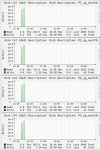zenon1823
Explorer
- Joined
- Nov 13, 2018
- Messages
- 66
Just when I think I hve ZFS mostly figured out, something makes me question my understanding. I have 2 pools - The first has 4 3TB drives as 2 mirrored vdevs. The second is 4 2TB drives in RaidZ1. As I understand from the countless threads I've read, when using mirrored vdevs files being read/wrote are distributed across vdevs. This is why you get better iops and random file access times especially with multiple users or vm workloads etc. And obviously when a file is wrote to a RaidZ1 vdev the write is stripped across all 4 drives with its parity.
But today I copied a large iso to a datastore on the mirrored pool, and I happened to notice that all 4 drives reported drive write activity. Why would this be since it was just a single file write, I thought mirrored pools didn't stripe files across vdevs like RAID10?
Pool Details:

Reported Activity:

But today I copied a large iso to a datastore on the mirrored pool, and I happened to notice that all 4 drives reported drive write activity. Why would this be since it was just a single file write, I thought mirrored pools didn't stripe files across vdevs like RAID10?
Pool Details:

Reported Activity:

